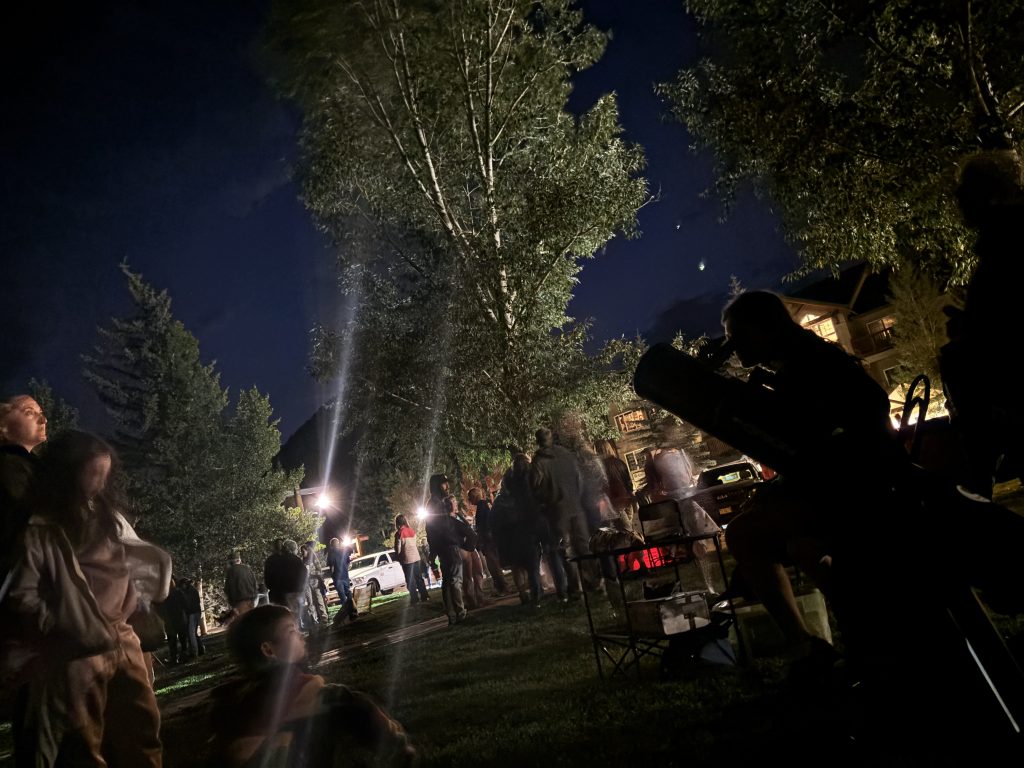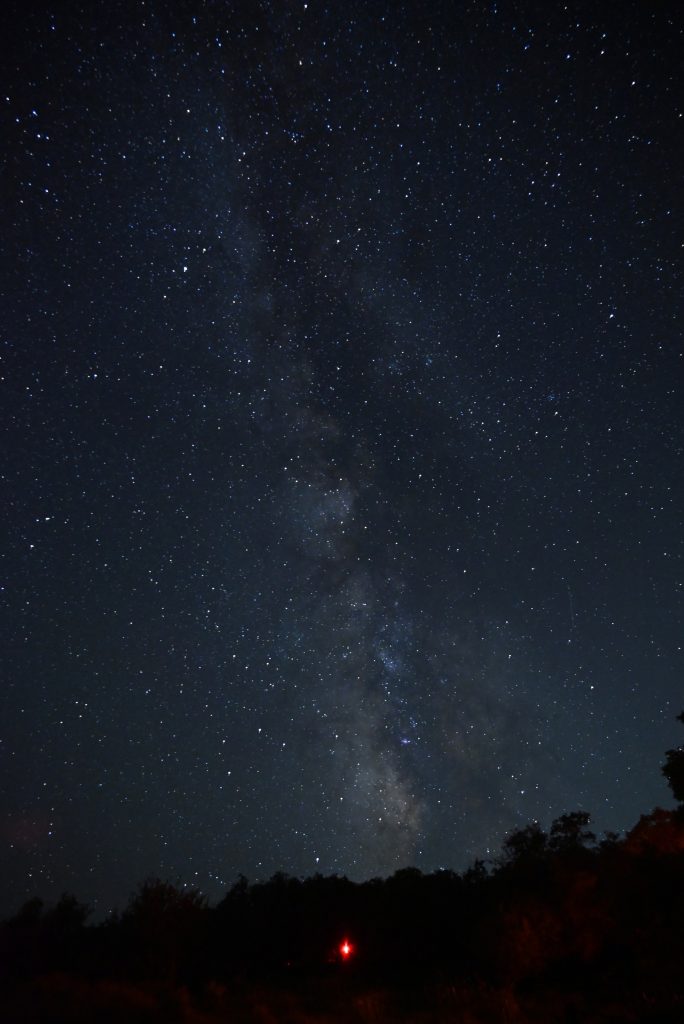‘Get friendly with the stars’: In Colorado, more than 30 places are working toward Dark Sky certifications
Description
On a cool night in August, more than 100 people gathered in a dark corner on Frisco Main Street.
The lights at the Frisco Historic Park were out. Phones were tucked away, out of sight. People lay on blankets in the grass and gathered in groups around telescopes. Astronomy guide Mark Laurin, who is better known as Astro Mark, urged the crowd to let their eyes adjust to the dark.
“I want you to get friendly with the stars,” Laurin said. “And really, what I want you to do is experience the universe.”
With a laser pointer, Laurin pointed out the prominent stars that create asterisms, which he explained are recognizable patterns of stars, like the Summer Triangle. He called attention to how some stars shine brighter than others, and the different colors of starlight.
Stopping sometimes to adjust the telescope seat for stargazers young and old, Laurin peppered the audience with questions about the night sky: “How do stars form, does anyone know?” he asked, before launching into a spiel about how clouds of cosmic dust and gasses condense to create stars.
The crowd chimed in with their own questions: “Can you see Orion’s belt?” No, that constellation is below the horizon during the summer, Laurin said. “How do you find the North Star?” First, find the Big Dipper, he explained, the North Star will be off the lip of the ladle.
Every few minutes, gasps and murmurs rippled through the crowd as a shooting star flashed across the sky. It was the peak of the Perseid Meteor Shower, one of the best meteor showers of the year, with up to 150 shooting stars each hour.
“Oh! That was a big one,” Laurin said, after a meteor streaked from one edge of the horizon to the other, leaving a smoky trail that lingered for several seconds.
Across Colorado, a growing movement is encouraging residents and visitors to connect with — and protect — the night sky.
<figure class="wp-block-image size-large">
 <figcaption class="wp-element-caption">A stargazer observes the heavens through a telescope during an event at the Frisco Historic Park on Aug. 12, 2025. Frisco is working toward becoming a certified Dark Sky Community, a process that includes both community outreach events as well as updating the town’s lighting ordinance to reduce unnecessary outdoor lighting. </figcaption><figcaption>Ryan Spencer/Summit Daily News</figcaption>
<figcaption class="wp-element-caption">A stargazer observes the heavens through a telescope during an event at the Frisco Historic Park on Aug. 12, 2025. Frisco is working toward becoming a certified Dark Sky Community, a process that includes both community outreach events as well as updating the town’s lighting ordinance to reduce unnecessary outdoor lighting. </figcaption><figcaption>Ryan Spencer/Summit Daily News</figcaption>Frisco is one of nearly three dozen locations in Colorado that are working toward certification as an official Dark Sky Place. The town’s Park After Dark event series this summer was a small part of this larger effort to foster appreciation for the night sky, change how communities think about outdoor lighting and reduce light pollution.
The towns of Berthoud, Leadville, Salida, Silverton, Meeker, Grand Lake, Estes Park, Old Snowmass, Telluride and Nederland are also among those working to become certified as Dark Sky Places. Earlier this year, Breckenridge became the first mountain resort town in the state to achieve that designation.
Colorado Gov. Jared Polis also announced in January that a dozen state parks, including Rifle Gap State Park and Steamboat Lake State Park, would go through the process to become designated as a certified Dark Sky Places.
“Colorado has been an emerging leader these past few years,” Dark Sky International Communities Program Manager Michael Rymer said. “It is a testament to the local advocacy that is going on. The people of Colorado take this seriously — not just to get the most certified places. They care about the night sky.”
DarkSky International
<figure class="wp-block-image size-large">
 <figcaption class="wp-element-caption">The Milky Way stretches over the South Rim of the Black Canyon of the Gunnison National Park, a certified Dark Sky Place in Colorado.</figcaption><figcaption>National Park Service/Courtesy photo</figcaption>
<figcaption class="wp-element-caption">The Milky Way stretches over the South Rim of the Black Canyon of the Gunnison National Park, a certified Dark Sky Place in Colorado.</figcaption><figcaption>National Park Service/Courtesy photo</figcaption>For all of human existence, people have lived under the stars. Throughout history, humans have drawn inspiration from the night sky, with the stars providing a canvas for oral traditions, myths and legends.
But since the invention of the light bulb, artificial light has increasingly infiltrated the natural world. Today, an estimated 80% of North Americans live in cities where light pollution muddies out views of the Milky Way Galaxy.
Places
- Black Canyon of the Gunnison National Park
- Browns Canyon National Monument
- Curecanti National Recreation Area
- Dinosaur National Monument
- Florissant Fossil Beds National Monument
- Great Sand Dunes National Park and Preserve
- Gunnison Gorge National Conservation Area
- Hovenweep National Monument
- Jackson Lake State Park
- Lake Fork Earth & Sky Center
- Mesa Verde National Park
- Top of the Pines
Communities
- Breckenridge
- Crestone
- Norwood
- Nucla & Naturita
- Paonia
- Ridgway
- Westcliffe
- Silver Cliff
“That’s the reality of our cause, that light pollution is a growing threat,” Rymer said. “It’s exponentially increasing around the world and we’re trying to slow it at least.”
In 1988, a group of researchers at an observatory near Tucson, Arizona, formed the nonprofit DarkSky International in response to the ever-encroaching artificial light that was impacting their ability to study the stars.
In 2001, the nonprofit launched its International Dark Sky Places program, which certifies communities, parks and other places that work to preserve and protect the darkness of the night sky.
Since then, the nonprofit has certified more than 230 Dark Sky Places across 22 countries and on six continents. That includes 165 certified Dark Sky Places in the United States and 19 in Colorado.
The Dark Sky certifications aim to bring attention to the problem of light pollution, foster stewardship of the night sky and create a framework for places to achieve long-term conservation targets while connecting people with nature.
“When you get to go to these places that are truly dark, you see not just a crazy amount of stars, but you get to see the structure of the Milky Way Galaxy,” Rymer said. “That’s what we want people to see, so that they’ll get moved to take action.”
In the U.S., only Utah, Texas and Arizona have more certified Dark Sky Places than Colorado, with 29, 21 and 20 certified places, respectively. But Colorado could soon surpass all of those states.
With more than 30 places working toward certification, “Colorado certainly leads the entire world in terms of the most places working toward certification,” Rymer said.
He said Colorado has been successful in rallying support for dark skies because of the grassroot efforts of local residents who care deeply for the night sky.
DarkSky Colorado, a state chapter of DarkSky International, has advocated for dark skies in the state for more than two decades. DarkSky Colorado member Richard O’Brien said the state chapter has been able to coordinate people’s individual interest in protecting the night sky into collective action.
Colorado already has a large population interested in the outdoors and, “like a lot of Western states, we still have quite a few truly dark places left,” O’Brien said. The fact that the Milky Way is visible from so many places in Colorado means residents here already know how powerful the night sky can be and are therefore passionate about preserving it, he said.
Another reason Coloradans get involved with the Dark Sky movement is to help reduce the impacts of light pollution on wildlife. O’Brien is the program chair for Lights Out Colorado, which encourages Coloradans to turn off outdoor lights during peak migratory seasons to help birds that navigate at night using the stars. He said this is probably the second biggest reason Coloradans get involved with the Dark Sky efforts.
“In Colorado, the cities are light polluted but there are a lot of places, particularly out in the mountains, that are not light polluted,” O’Brien said. “It’s really worth protecting that pristine environment, and a lot of people get excited about that.”
Astrotourism
<figure class="wp-block-image size-full">




